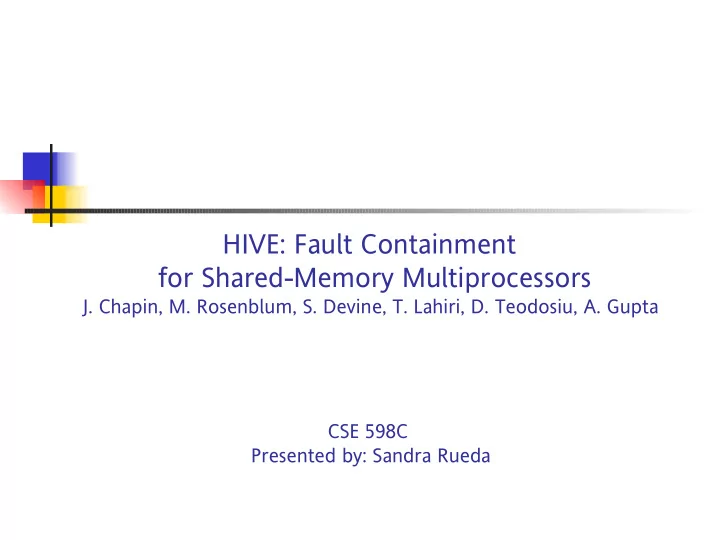

HIVE: Fault Containment for Shared-Memory Multiprocessors J. Chapin, M. Rosenblum, S. Devine, T. Lahiri, D. Teodosiu, A. Gupta CSE 598C Presented by: Sandra Rueda
The Problem O.S. for managing FLASH architecture (large shared-memory multiprocessor) 2L$ … … Mem Proc CC Net I/O Set of nodes connected in a mesh NUMA Jan 30,2006 2
Hive: Main Goals Memory Sharing: improving Performance Possible Failures: A faulty node makes that node’s memory inaccessible A faulty node returns wrong values for reads Software failures may corrupt other node’s memory Jan 30,2006 3
Main Goals Fault Containment: Hardware or software faults are confined to the cell where they occurred, as a consequence just that cell crashes. Scalability: Few resources are shared among different cells. More processors → more cells → more parallelism Jan 30,2006 4
O.S. Architecture Multicellular architecture: processors are grouped into cells. An independent kernel manages each cell (UNIX SVR4). Memory Organization: Cell Organization: Cell n Global … … … Address Space Cell Cell 1 Local Address Cell 0 Space Jan 30,2006 5
Fault Containment (1) Failure Sources Sources and control methods: Message exchange (RPC): timeout + message check Remote reads: careful_reference + message check Remote writes: Internal data: firewall User level data: Protection of local space Preemptive discard Jan 30,2006 6
Fault Containment (2) Control Methods Careful_reference protocol prevents errors from causing a kernel panic. Save context Check the memory range belongs to the expected cell Copy data values Check every remote data structure Careful_off Jan 30,2006 7
Fault Containment (3) Control Methods The Firewall controls which processors are allowed to modify each region of main memory. Only the local processor can change firewall bits. Rights are assigned to: First process that requests a writable mapping to the page. All the processors in a cell. Preemptive Discard (recovery) Jan 30,2006 8
Fault Containment (4) Detection Detection of a failure: RPC request times out Memory reading operation causes a bus error Periodic updating of a shared location fails Data fails consistency check When a failure is detected then an agreement protocol is run among other cells Jan 30,2006 9
Fault Containment (5) Recovery First Phase: Each cell flushes its TLB and remove any remote mapping. Second Phase: At the end of the first phase there is no pending remote access, so it is possible to revoke firewall write permissions. The virtual memory subsystem detects pages that were writable by a failed cell and notifies to the file system. Jan 30,2006 10
Fault Containment (6) Recovery Preemptive Discard: It is possible for a process to fetch stale data from disk after a recovery Only processes that opened a file before a failure will receive I/O errors. It is implemented with a generation number, mismatches about the number will generate an error. Jan 30,2006 11
Memory Sharing (1) Two types of memory sharing: logical level: a process on a cell maps a data page from another cell into its address space cell i cell j mem mem pages pages pfdat imp pfdat table table exp Jan 30,2006 12
Memory Sharing (2) Two types of memory sharing: physical level: one cell transfers control over a page frame to another cell i cell j mem mem pages pages pfdat brw pfdat table table X Jan 30,2006 13
Memory Sharing (3) WAX: It is a user level process that may have access to all cells. In this way it is able to consolidate a global view of the system. Some decisions are made based on the global view. For instance processes priorities. … Proc i Proc m WAX … Cell 0 Cell n Jan 30,2006 14
RPC: Optimization Some times cells exchange information via RPC FLASH architecture includes hardware support to minimize RPC latency The mechanism is based on the cache-line delivery mechanism used by the cache coherency protocol (SIPS: Short Interprocessor Send Facility) Primitive is reliable No message fragmentation Jan 30,2006 15
Experimental Results At the time of the paper Hive was a prototype FLASH hardware was not available yet Authors used SimOS Jan 30,2006 16
Simulation Environment Hardware 4 processors MIPS 200 MHz memory 128 MB 4 disk controllers, each with one attached disk 4 ethernet interfaces 4 consoles Hive 4 cells each cell: 1 processor, 32 MB memory, 1 interface, 1 disk Jan 30,2006 17
Simulation Environment Memory Hierarchy (per processor): Instruction cache: 32 K, two-way-associative Primary data cache: 32 K, two-way-associative Secondary unified cache: 1 MB, two-way-associative Given miss penalty Given SIPS latency Given interrupt latency Given disk latency Some values are based on other models Jan 30,2006 18
Simulation Environment Performance Tests Expected workloads (scientific application, parallel application) Times for IRIX 5.2 (reference) Different configurations: one, two, four cells Conclusion: The partition into cells has little effect on performance, and it allows fault containment Jan 30,2006 19
Simulation Environment Fault Injection Tests Difficult to predict the reliability of a complex system Fault injection tests are used to detect if reliability mechanisms are working properly Authors chose to inject failures in situations where it seemed that a fault in one cell could corrupt another They checked files after recovery to detect data corruption The simulator allowed them to recreate scenarios from a specific checkpoint Jan 30,2006 20
Conclusion Simulation Environment Advantages [1] Evaluation of hardware support Evaluation of designed mechanisms Evaluation of tradeoffs Problems [2] Simulator Bugs Omissions Lack of Detail Key Features define if it is useful Jan 30,2006 21
References [1] Hive: Fault Containment for Shared-Memory Multiprocessors, J. Chapin, M. Rosenblum, S. Devine, T. Lahiri, D. Teodosiu, and A. Gupta, SOGOPS 1995. [2] Flash Vs. Simulated Flash. Closing the Simulation Loop. Jeff Gibson, Robert Kunz, David Ofelt, Mark Horowitz, John Hennessy, Mark Heinrich. SIGARCH Volume 28 , Issue 5 (December 2000). Jan 30,2006 22
Recommend
More recommend